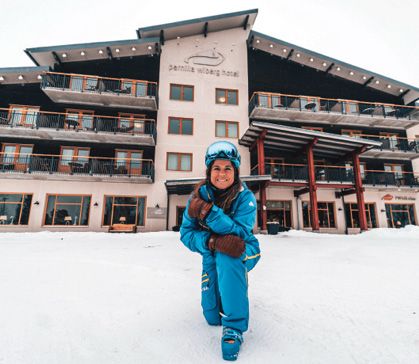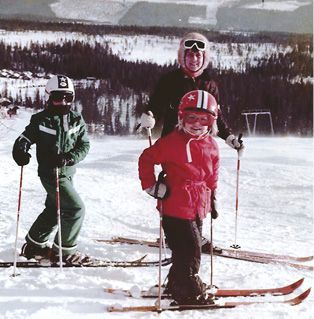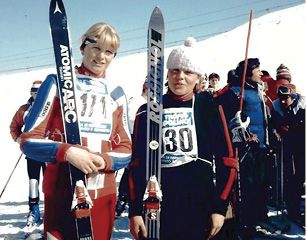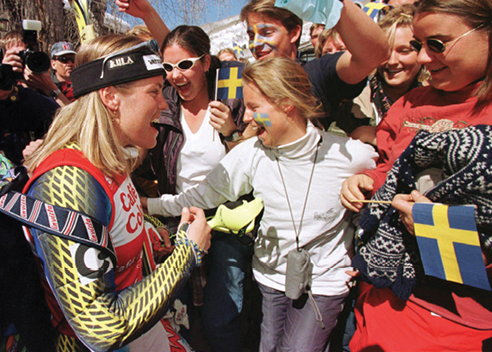
SKIING HISTORY
Editor Kathleen James
Art Director Edna Baker
Contributing Editor Greg Ditrinco
ISHA Website Editor Seth Masia
Editorial Board
Seth Masia, Chairman
John Allen, Andy Bigford, John Caldwell, Jeremy Davis, Kirby Gilbert, Paul Hooge, Jeff Leich, Bob Soden, Ingrid Wicken
Founding Editors
Morten Lund, Glenn Parkinson
To preserve skiing history and to increase awareness of the sport’s heritage
ISHA Founder
Mason Beekley, 1927–2001
ISHA Board of Directors
John Fry (1930-2020), Chairman
Seth Masia, President
Wini Jones, Vice President
Jeff Blumenfeld, Vice President
John McMurtry, Vice President
Chan Morgan, Treasurer
Einar Sunde, Secretary
Richard Allen, Skip Beitzel, Michael Calderone, Christin Cooper, Art Currier, Dick Cutler, Chris Diamond, David Ingemie, Joe Jay Jalbert, Rick Moulton, Wilbur Rice, Charles Sanders, Bob Soden (Canada)
Presidential Circle
Christin Cooper, Billy Kidd, Jean-Claude Killy, Bode Miller, Doug Pfeiffer, Penny Pitou, Nancy Greene Raine
Business & Events Manager
Kathe Dillmann
P.O. Box 1064
Manchester Center VT 05255
(802) 362-1667
kathe@skiinghistory.org
Membership Services
Laurie Glover
(802) 375-1105
laurie@skiinghistory.org
Corporate Sponsorships
Peter Kirkpatrick
(541) 944-3095
peterk10950@gmail.com
Bimonthly journal and official publication of the International Skiing History Association (ISHA)
Partners: U.S. Ski and Snowboard Hall of Fame | Canadian Ski Museum and Hall of Fame
Alf Engen Ski Museum | North American Snowsports Journalists Association | Swiss Academic Ski Club
Skiing History (USPS No. 16-201, ISSN: 23293659) is published bimonthly by the International Skiing History Association, P.O. Box 1064, Manchester Center, VT 05255.
Periodicals postage paid at Manchester Center, VT and at additional mailing offices. Postmaster: Send address changes to ISHA, P.O. Box 1064, Manchester Center, VT 05255
ISHA is a 501(c)(3) public charity. EIN: 06-1347398
Written permission from the editor is required to reproduce, in any manner, the contents of Skiing History, either in full or in part.
Where Are They Now? Pernilla Wiberg
From her home base in Monaco, the Swedish superstar is a TV commentator, advocate for World Cup racer safety, entrepreneur, and homeschooling mom.
When you’re a world champion, an Olympic champion, a World Cup overall champion and a successful TV commentator, you’re not the average mom. But last March, Swedish alpine ski-racing legend Pernilla Wiberg found herself at home in Monaco, doing what many of the world’s moms were doing: homeschooling her kids and busting outdoors for exercise.
Photo top of page: Wiberg in the the final slalom race of the season on March 16, 1997 in Vail.
“It’s a rollercoaster,” says the 50-year-old Wiberg of parenting, pandemic or not. “It’s not easy and there is not [only] one way to succeed.”
Wiberg and her husband Bødvar Bjerke, a former Norwegian national alpine team coach, share parenting duties for their son and daughter, ages 17 and 13. Most winters, Bjerke covers for Wiberg when she travels extensively for her TV work, from late October through March. Last spring, while the family hunkered into quarantine in Monaco, back in Sweden Wiberg’s brother, sister and mother carried on their lives with no restrictions.
“Nobody can say right now if the approach that Sweden has taken with COVID-19 will in the end be the right one or not,” says Wiberg of the nation’s less-restrictive “herd immunity” policies. “It will take some years.”
 Wiberg’s journeys include regular trips to the Pernilla Wiberg Hotel in Idre Fjall, a small ski resort and former mining village tucked up close to the Norwegian border in the northwest part of Dalarna in Sweden. The ski-in, ski-out hotel was built in 2003, shortly after Wiberg retired from racing. “It was the perfect project to jump into,” says Wiberg. She drew on lessons learned as a world-class athlete, from navigating sponsors and negotiating contracts to “doing mistakes,” she says. Today, Wiberg is engaged in all aspects of the hotel, from designing skier-friendly features—including small drying cupboards and lots of hooks for gear in every room—to overseeing marketing and consulting on menus. Her fierce dedication to skiing has shifted from winning races to sharing her love for the sport.
Wiberg’s journeys include regular trips to the Pernilla Wiberg Hotel in Idre Fjall, a small ski resort and former mining village tucked up close to the Norwegian border in the northwest part of Dalarna in Sweden. The ski-in, ski-out hotel was built in 2003, shortly after Wiberg retired from racing. “It was the perfect project to jump into,” says Wiberg. She drew on lessons learned as a world-class athlete, from navigating sponsors and negotiating contracts to “doing mistakes,” she says. Today, Wiberg is engaged in all aspects of the hotel, from designing skier-friendly features—including small drying cupboards and lots of hooks for gear in every room—to overseeing marketing and consulting on menus. Her fierce dedication to skiing has shifted from winning races to sharing her love for the sport.
THE EARLY DAYS

Sweden’s winningest female ski racer did not grow up in ski country, but rather 200 miles south, in Norrköping. As the middle of three athletic kids of school-teacher parents, Pernilla participated in a variety of activities, including basketball, running, gymnastics, dance and music. She built her strength and her will by chasing her older sister, Annika. The family learned to ski at the local hill, 400-meter-long Yxbacken, and on school holidays the family made the five-hour car trek to the mountains.

She started racing at age 11 and found quick success on the slopes. In her first international event, at age 14, she won the Tropheo Topolino slalom. At age 16, she joined her sister at Malung—the ski academy that 2018 Olympic gold medalist Frida Hansdotter later attended—and continued her rise through the ranks, competing in the 1988 World Junior Championships.
Athletic kids growing up in Sweden in the 1980s had a god for each season, and they were named Ingemar Stenmark and Björn Borg. “It was amazing,” says Wiberg, recalling the time her alpine-racing idol, Stenmark, walked down a corridor where she and other athletes were stretching during a training camp. “It looked like he was floating over the ground.”
Wiberg suffered a devastating knee injury while competing in Vermont, just before the 1989 World Junior Championships in Alaska. The U.S. Ski Team athletes and coaches convinced the 18-year-old to stay in the States, and to see orthopedic surgeon Dr. Richard Steadman in South Lake Tahoe. After a five-hour surgery, and rigorous rehab that included delivering mail by bicycle to rebuild her strength, Wiberg became another Steadman success story.
But she pushed herself too hard. It was only after her family forced her to go on vacation at Christmas, and she stopped training for a week, that things started to click. She returned to racing in February 1990, and by March, less than a year after surgery, she was on a World Cup slalom podium.
THE TITLES

The following season Wiberg nabbed her first World Cup win, a slalom in January. The next month, at the 1991 World Championships in Saalbach, Wiberg charged back from a 1.6 second deficit on the first run of the giant slalom to win her first World title. She backed that up with Olympic GS gold the following year in Albertville. Wiberg would add speed events to her repertoire, eventually winning in all five World Cup events, and earning World Championships and Olympic medals in four.
The Swedish ski team was small and close, under the direction of Jalle Svanberg. They often trained with the Americans, and Julie Parisien fondly remembers NorAm trips and later U.S. Ski Team training camps with Wiberg, her teammate Ylva Nowen, and Svanberg.

“They were a great team, and such fun,” says Parisien, who remembers Wiberg’s sheer strength and superstar aura. When breakaway poles came on to the scene, the Swedish women were the first to master the technique, meticulously testing ways to clear the gates most efficiently. After scoring her first Super G win in 1994, and then Olympic gold in combined that year, Wiberg started running downhill. She teamed up with the Americans for off-season training and Picabo Street took Wiberg under her wing. “I was like a sponge,” says Wiberg. “I listened to everyone.”
Svanberg, who spent 11 years as Wiberg’s coach, starting at age 14, fostered this innovative and daring spirit. “From early on, she understood that to be the best, she had to do something nobody else did,” says Svanberg. That included exhaustive equipment testing and tweaking, experimenting with favorite smells to induce a “flow state” (Svanberg: “I’m not sure it worked, but we tried”), and working with a leading neurologist whose studies suggested doing max squats the day before a race.
Wiberg’s ability to come back from seemingly insurmountable challenges—including injuries, time deficits or in-season slumps—was legendary and, in her mind, entirely innate. “You are born with the ability to rise from falling, or not,” she says. Svanberg recalls the time a sports psychologist, after one meeting with the Swedish team, told Wiberg, “You don’t need me.”
Wiberg’s skiing success, bolstered by her dazzling smile and well-spoken, friendly demeanor, translated to popularity in her home country and beyond. After winning her first (of four) World titles, she shelved her university studies in economics and sport became her business education. That same year she released the song and music video Privilege. In 1992, after her first of two Olympic gold medals, she united with other Swedish athletes to try to create a more favorable tax status to preserve their earnings. Ultimately, and at first reluctantly, she followed the path of her sports heros Stenmark and Borg and moved to Monaco in 1995. “In the end it was good,” says Wiberg, who explains that Monaco’s proximity to the Alps made it far more convenient than Sweden for a ski racer.
As with many successful athletes, Wiberg sought greater independence, and specifically wanted Bjerke to travel with her for support. When Swedish team members opposed that, she went her own way, spending one year year training with the Norwegian team, and another with Svanberg as her private coach. That year, 1996, Wiberg won world titles in slalom and combined, and the following year she won the World Cup overall title. Despite their success together, she and Svanberg agreed the private team dynamic wasn’t healthy. Ultimately, Wiberg returned to the Swedish team. She and Nowen, with whom she had the original conflict, remain close friends today.
AFTER RACING
By the time Wiberg retired from racing, after the 2002 Olympics, she had racked up three Olympic medals (two gold), six World Championship medals (four gold), one World Cup overall title, an individual slalom World Cup title and 24 World Cup victories across all five disciplines. In 2019 Wiberg was given the Swedish Sports Academy’s Honorary Award, which goes to “the sportsperson who, through their ongoing efforts, brought admiration and respect and enriched Swedish sport.”
Wiberg remains a regular on the World Cup, but now as a commentator for Swedish TV, traveling to the studio in Stockholm on weekends, and sometimes to the ski venues. Olympic medalist and longtime commentator Christin Cooper-Taché appreciates Wiberg’s talents on the hill and in the booth. At Sochi the two would exchange notes daily during the course inspection at dawn. “She is very smart, and very informed and objective about ski racing,” says Cooper. Wiberg enjoys the challenge and the connection. “[Racing] had been my life for so many years, and now I can give back to my sport by explaining racing to viewers.”
Wiberg gives back in other ways, too. While still competing, she was elected by her peers as chairperson for the FIS athletes commission from 1996–2000, and then to the IOC athletes commission from 2002–2010. Since then her involvement has been dizzying, including her work for the past ten years with the FIS Alpine Equipment Working Group. This international group of World Cup athletes and coaches has helped to identify and develop ways to reduce injuries by looking at things like equipment design, cut-resistant fabrics, and factors like physical training, balance, physiology and technique. Wiberg notes how few injuries well-balanced skiers like Mikaela Shiffrin and Marcel Hirscher have had, and believes that plays a key role in injury prevention. She also advocates a backed-off schedule to allow athletes longer recovery times.
Along with her work for the FIS and IOC, Wiberg is a “Champion of Peace” for Peace and Sport, an international NGO, and a board member of both the World Olympian Association and Svenska Olympier. The former is dedicated to inspiring the 100,000-plus Olympians around the globe to help society and fellow Olympians, and the latter is an organization of all living Olympians in Sweden. In addition to her many volunteer roles, she serves on a professional board through her work with MIPS (multi-directional impact protection system) helmet technology.
Despite her own mental strength in competition, Wiberg understands the struggle for many athletes, and acknowledges the challenges of success. “When you have a medal, everyone sees you as a star,” she says. “They expect you to be a superhero and if you are not, the fall is so long. If you feel fragile, you don’t want to tell anyone. We have to say it’s okay to not feel okay.”
Wiberg’s own children enjoy recreational skiing and are active in soccer and gymnastics. After two months at her summer home in Sweden, the family is back in Monaco. Her TV duties will be in the Stockholm studio until the new year, when she hopes they shift to being on site at World Cup venues. What’s next on her rollercoaster? “People expect you to have goals in normal life, but you don’t,” she says. “I still don’t have a career goal, but jobs come to me for different reasons.”
Whatever comes along, Wiberg will attack it in her usual style, with guts and resolve. “All top athletes like to do things 100 percent!” 
reuters / alamy stock photo
reuters / alamy stock photo

Table of Contents

Corporate Sponsors
ISHA deeply appreciates your generous support!
WORLD CHAMPIONSHIP ($3,000 AND UP)
Gorsuch
Polartec
WORLD CUP ($1,000)
Aspen Skiing Company
BEWI Productions
Bogner
Boyne Resorts
Dale of Norway
Darn Tough Vermont
Dynastar | Lange | Look
Fairbank Group: Bromley, Cranmore, Jiminy Peak
Gordini USA Inc. | Kombi LTD
HEAD Wintersports
Hickory & Tweed Ski Shop
Intuition Sports, Inc.
Mammoth Mountain
Marker-Volkl USA
National Ski Areas Association (NSAA)
Outdoor Retailer
Rossignol
Ski Area Management
Ski Country Sports
Snowsports Merchandising Corporation
Sport Obermeyer
Sports Specialists, Ltd.
Sun Valley Resort
Vintage Ski World
Warren and Laurie Miller
World Cup Supply, Inc.
GOLD ($700)
Race Place | BEAST Tuning Tools
The Ski Company (Rochester, NY)
Thule
SILVER ($500)
Alta Ski Area
Boden Architecture PLLC
Dalbello Sports
Ecosign Mountain Resort Planners
Fera International
Holiday Valley
Hotronic USA, Inc. | Wintersteiger
MasterFit Enterprises
McWhorter Driscoll, LLC
Metropolitan New York Ski Council
New Jersey Ski & Snowboard Council
NILS, Inc.
Russell Mace Vacation Homes
Schoeller Textile USA
Scott Sports
Seirus Innovations
SeniorsSkiing.com
Ski Utah
Swiss Academic Ski Club
Tecnica Group USA
Trapp Family Lodge
Western Winter Sports Reps Association
World Pro Ski Tour


